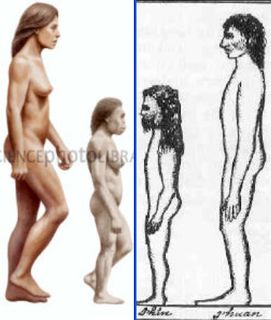-
Original Panic
I'hin man has been extinct for
over 3,000 years. "The I'hins as a race became extinct upon the earth about 3,000 years B.K." - page 161 of SEVEN
YEARS THAT CHANGED THE WORLD, 1941-1948 (1940) by Wing Anderson.
Oahspe The Lords' Fifth
Book CHAPTER 5:
2. Here follows what became of these I'hins, namely:
3. Those that came to Guatama survived
twenty one thousand years, and then became extinct.
4. Those that came to Jaffeth survived
twenty one thousand years, and then became extinct.
5. Those that came to Shem survived
twelve thousand years, and then became extinct by amalgamation. |516|
6. Those
that came to Ham survived twenty one thousand years, and then became extinct by amalgamation.
7. Those of Guatama attained to one thousand large
cities, and three thousand small cities, being more than four million souls. And they never had any king or queen, or other
ruler, except the Lord, who ministered to them through the city fathers. And they retained their sacred name of Guatama to
the last of them; but the I'huans called them Oech'lo'pan, signifying, people of another world [continent --Ed.]. |517|
14. Regarding the tribes that went in the two ships to the north land (Japan), after a thousand years, no man could draw
the line between them and the I'huans, for they mingled
with them, and were lost, as I'hins. Nevertheless, they redeemed the barbarians into wisdom and peace. http://oahspestandardedition.com/OSE_19.html
...the I'hins became extinct as a separate people or merged
with such races as the Hebrews [Israelites] and the Vedic tribes of India ...page 81 of DARKNESS,
DAWN AND DESTINY by Augustine Cahill.
OAHSPE:
Book of Thor: CHAPTER I: 18. Yathai inquired as to the races of men on earth, and as to the times of their termination.
19. God said: In twelve thousand four hundred years the I'hin race, the mound
builders, will come to an end. And in that day the Ghans will have triumphed over all the
lands and waters of the earth.
Oahspe Book of
Sapah OSIRIS.
58. From Kosmon [1848], the
present time, to Thor (the first) - 15,400 years before Kosmon.
15,565
years ago (from 2013).
15565
- 12400 = 3165 years ago the I'hin race became extinct. Homo sapiens sapiens continued to flourish.
The above text in Oahspe (according to the text) of when the I'hin race would come to an end (termination) or extinction
12,400 years after the time of the Etherean God Thor (the first) which was 3,165 years ago before 2013 when I calculated it
and posted it on my website back in 2013. - studyofoahspe.com author.
------------------------------------------------------------------------------------------
The size and colors of the I'hins according
to the text of Oahspe:
According to Oahspe First
Book of the First Lords: Chapter II: 4. The I'hins were
white and yellow, but the Druks were brown and black; the I'hins were small and slender, but the Druks were tall and stout.
OAHSPE: The Lords' Fifth Book Chapter III:
4. Of all colors (black, white, yellow, copper,
red and brown) were the tribes of Ham; nevertheless, they were I'hins (Faithists),
Could not find any text in Oahspe (according to the text) that says the I'hins
were tall.
Modern human and Homo floresiensis
Notice above the orthographic
projection lines from fossil anatomical reconstruction of Homo floresiensis to Newbrough's Oahspe drawing of an I'hin and the matching
symmetry of middle calf muscle, knee, hand, bottom and middle of buttocks, elbow and lower back-top
of buttocks, nipple-chest peak, top of shoulder-bottom of neck.
Orthographic projection is a type of similarity
meter of two things compared:
or·tho·graph·ic
pro·jec·tion.
a method of projection in which an object is depicted or a surface mapped using parallel lines to project its shape onto
a plane.
https://www.bing.com/search?q=Orthographic+projection
 Above left to right: (b) modern human and (a) Homo floresiensis = (a) I'hin (phenotype) and
(b) I'huan.
Above left to right: (b) modern human and (a) Homo floresiensis = (a) I'hin (phenotype) and
(b) I'huan.Illustration of I'hin and I'huan (in Oahspe) above was drawn by John Ballou Newbrough.
Estimating the height of the I'hin at about 3 or 4 feet tall, the average height of the I'huan was from 5 feet 6 inches to
6 feet 6 inches.
MOSES, an Egyptian lawgiver. He was cotemporaneous with Capilya of India and Chine of China, living two
thousand four hundred years after Abram (3400 B.K.). Moses was a large man, a pure I'huan, copper colored, and of great strength,...[genotype Rs1815739(C;C) better performing muscles]. 
Above is a face to face head
to head comparison of forensic reconstruction of Homo floresiensis
and I'hin (drawn by Newbrough) with 9 matching
projection lines.
Homo floresiensis ("Flores
Man"; nicknamed "hobbit"[2]) is an extinct species
in the genus Homo.
The remains of an individual who would have stood
about 1.1 m (3 ft 7 in) in height
were discovered in 2003 at Liang Bua on the island of Flores in Indonesia.
This hominin had originally been considered remarkable for its survival until relatively recent times, only 12,000 years ago.[7] However, more extensive stratigraphic and chronological work has pushed the dating of the most recent evidence
of its existence back to 50,000 years ago.[8][9][10] The Homo floresiensis skeletal material is now dated from 60,000 to 100,000 years ago; https://en.wikipedia.org/wiki/Homo_floresiensis
The fossils of H. floresiensis date to between about 100,000
and 60,000 years ago.
H. floresiensis individuals stood approximately 3 feet 6 inches tall,
Year of Discovery: 2003
http://humanorigins.si.edu/evidence/human-fossils/species/homo-floresiensis
The dating of Homo floresiensis fossils date to between 100,000 and 60,000
years ago with An arm bone dating to about 74,000 years old. The Oahspe dates for the origin of the I'hin race is about 73,000
years ago.
The
geological time scale of Homo floresiensis (which resembled the Oahspean I'hin race) does correspond with that of Oahspe and Oahspe had this information 122 years BEFORE Homo
floresiensis was first discovered.
Red
circle below shows the location of the Island
of Flores in Indonesia next to where the Continent of Pan was 25,000 years ago.